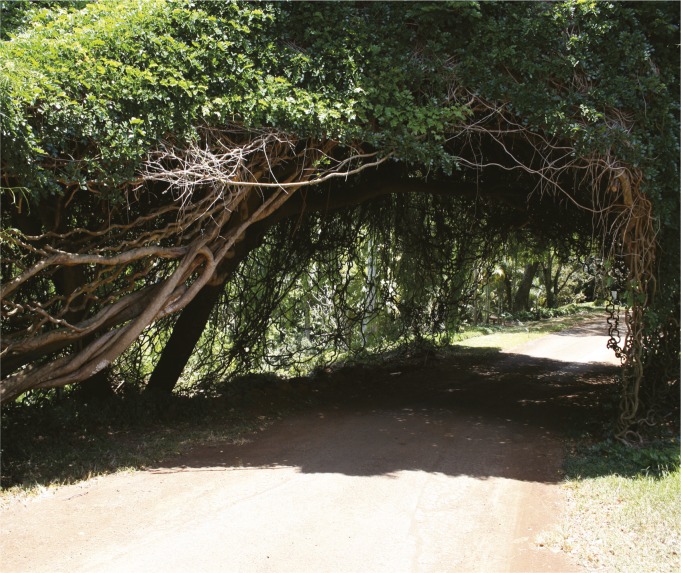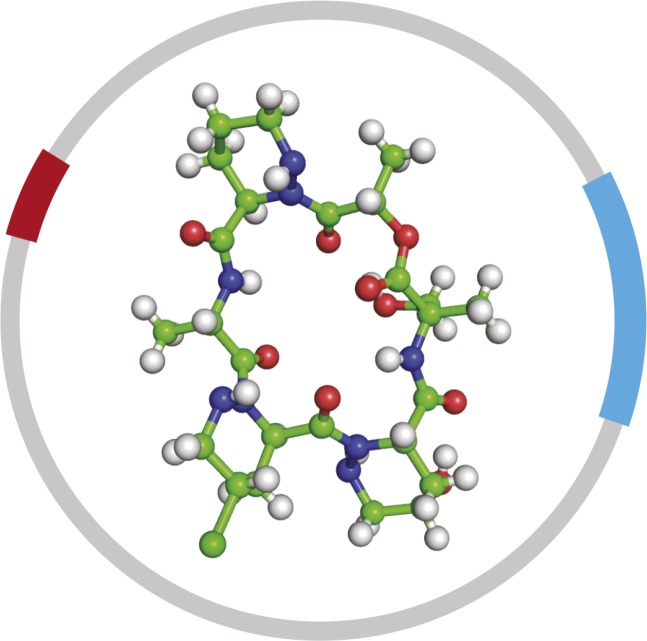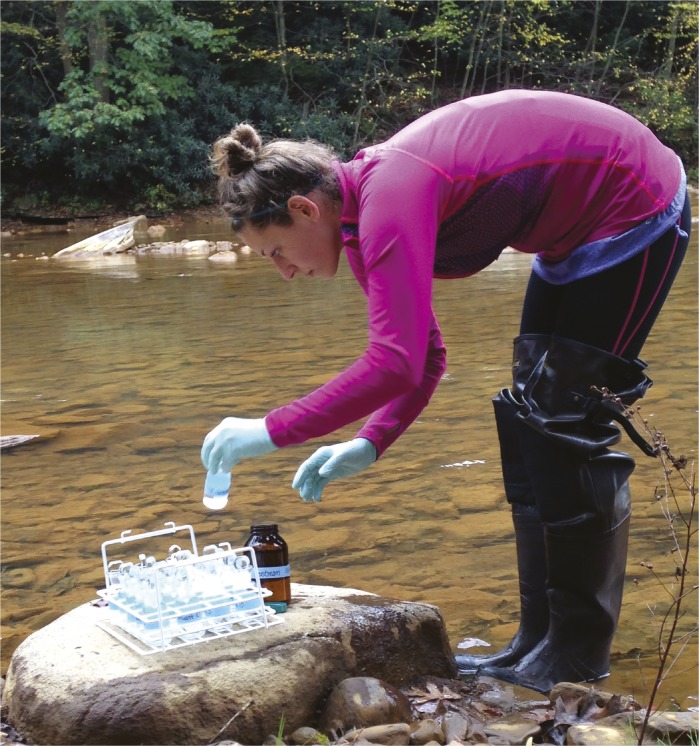Woody liana vines and tropical carbon storage
Lianas form a canopy over a road. Image courtesy of Wikimedia Commons/Gh5046.
The abundances of woody vines called lianas are increasing in tropical forests, which store nearly 30% of aboveground terrestrial carbon and serve as a significant global carbon sink. To assess the impact of lianas on carbon storage and sequestration in tropical forests, Geertje van der Heijden et al. (pp. 13267–13271) compared carbon storage in experimental plots in Panama that had been cleared of lianas with tropical forest plots that had not been cleared. After 3 years of growth, the plots with lianas displayed around 76% less accumulation of biomass than the liana-free plots. According to the authors, the difference is due to increased tree mortality and reduced tree growth when lianas are present. Liana plots also stored more aboveground carbon in leaves and less carbon in woody stems than liana-free plots. Carbon stored in leaves, the authors note, can return to the atmosphere much more quickly than carbon stored in woody stems. Simulations of future forest growth suggest that lianas may decrease long-term forest biomass storage by around 35%. The results suggest that growth and expansion of lianas throughout tropical forests may hamper the capacity of forests for carbon storage and accumulation, according to the authors. — P.G.
Antifungal compounds and fungus-farming ants
Gerumycin A and its plasmid.
Tropical ants in the genus Apterostigma and Trachymyrmex harvest plant matter and use it to nurture fungal gardens. The ants’ crop is shielded from fungal pathogens by small molecules produced by symbiotic bacteria residing on the ant exoskeleton. Clarissa Sit et al. (pp. 13150–13154) analyzed the molecules’ genomic and biosynthetic architectures to explore the properties of antifungal compounds produced by ant-dwelling microbes from Panama, Costa Rica, and Peru. The authors sequenced the genomes of three ant-associated microbes in the Pseudonocardia genus and identified biosynthetic gene clusters encoding three previously unknown antifungal molecules, dubbed gerumycin A, B, and C. The molecules bear structural similarity to dentigerumycin, a selective antifungal compound known to inhibit the growth of a common fungal pathogen, Escovopsis. Interestingly, all three gerumycins have identical core structures despite being encoded from strikingly different genomic architectures, including genomic islands, a plasmid, and spatially separated genetic loci. According to the authors, the findings could inform future drug discovery by demonstrating how biosynthetic gene clusters evolve to produce antifungal compounds with novel molecular and functional features. — A.G.
Plant colonization of ancient Earth
Plants colonized Earth around 450 million years ago, a watershed moment that fundamentally reconfigured the climate, founded terrestrial ecosystems, and spurred animal evolution. However, how the first land plants survived long enough in a seemingly unfertile environment to successfully establish themselves has remained unclear. Pierre-Marc Delaux et al. (pp. 13390–13395) analyzed DNA and RNA of some of the earliest known land plants and green algae, and found evidence that an essential symbiotic signaling pathway in modern plants was partially in place before plants found purchase on the continents. The pathway uses the enzyme calcium- and calmodulin-dependent protein kinase to mediate a mutualism with arbuscular mycorrhiza, fungi that help plant roots obtain nutrients and water from soil in exchange for carbon. Furthermore, the genes required for this relationship continued to develop after plants made the transition, suggesting that the symbiosis continued to evolve in this original ancestor through successive generations, according to the authors. Hence, the authors conclude, the most recent common ancestor of all living land plants may have carried a preexisting adaptation that likely allowed it to interact with beneficial fungi and eventually take root on Earth’s barren surface. — T.J.
Parasite virulence and host mating strategies
Parasites are thought to play an important role in the evolution of host mating strategies, which in turn affects parasite transmission and evolution. However, little is known about how parasites coevolve with host mating strategies. Ben Ashby and Michael Boots (pp. 13290–13295) developed a theoretical model of how host mating behavior coevolves with the virulence of a sexually transmitted parasite. The authors found that coevolution can lead to stable levels of parasite virulence and host mate choosiness, or cycling in these traits between high and low levels of virulence or choosiness. Cycling is more likely to occur when hosts have intermediate life spans, and both relatively long and short host life spans were predicted to select against the choosiness of hosts for their mates. Coevolution was also predicted to result in an inverse relationship between parasite virulence and host mate choosiness, with choosier hosts selecting for lower parasite virulence, and less choosy hosts selecting for higher parasite virulence. The authors also found that genetic drift and positive frequency-dependent selection can cause contrasting levels of host mate choosiness to evolve from the same starting conditions. The authors suggest that parasites play a key role in shaping the evolution of host mating strategies, and that their role must be viewed in the context of coevolution with their hosts. — S.R.
Organic compounds in Marcellus Shale groundwater
Surface water samples were collected in northeastern Pennsylvania to assess organic chemicals.
Elevated levels of organic compounds in drinking-water wells in the vicinity of the Marcellus Shale in northern Pennsylvania have raised concerns that the organic chemicals used in hydraulic fracturing operations have migrated to drinking-water aquifers. Brian Drollette et al. (pp. 13184–13189) analyzed 64 groundwater samples from residential wells overlying the Marcellus Shale and found trace concentrations of organic compounds, including bis(2-ethylhexyl)phthalate, a compound known to be an additive in hydraulic fracturing operations. To investigate the source of the compound, the authors used chemical characterizations of deep saline groundwater, analysis of noble gas isotopes present in the water samples, and spatial distributions of hydraulic fracturing wells, particularly wells with disclosed health and safety violations. The authors found no evidence that the compounds had migrated to the wells from deep shale formations, faulty well casings, underground fuel storage tanks, or from waste-holding ponds. The results suggest that the most likely short-term path for transport of organic compounds to residential wells is through surface spills of chemical additives, not through deep subsurface transport to drinking-water aquifers, and that drinking-water wells near reported spill sites could be targeted for monitoring and treatment as needed, according to the authors. — P.G.





